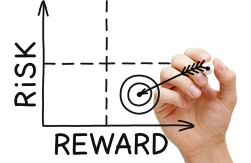Money Management with Risk/Reward Ratios
Entering or exiting a trade is the subject of a longstanding debate among traders: When is the right time to do this, and what if I’m wrong about the whole process? There is no exact answer to the above, but one thing is for sure: Risk/reward ratios are key to money management, and will keep a trader safe in the volatile Forex markets. When trading with a risk/reward approach, a trader already has a plan in mind, and this tells much about the general trading style. Without that, trading is perceived as being random, and it will only lead to losses. Risk/reward ratios are an important money management tool, and they should be part of any portfolio approach. No matter how smart the trading is, without managing the risks, the approach will eventually turn in a loss.
| Broker | Bonus | More |
|---|
Defining a Proper Risk/Reward Ratio
The risk/reward notion means that Forex traders risk several pips in order to gain more pips. A positive risk/reward ratio is not necessarily a good thing, as the ratio should be bigger than 1, not bigger than zero. This means that in earnest, the number of pips gained should be bigger than the number of pips that are being risked, and this makes for a solid risk/reward ratio. Unfortunately, there are many traders who use risk/reward ratios that are not adequate for long-term success in Forex trading.
Minimum Conditions
As a rule of thumb, a proper risk/reward ratio is one that is greater than 1.0. That means that for 1 pip risked, the reward should be bigger than 1. Anything below 1 is unsustainable in the long run. To give you an example, this mean that if you take a long trade on the EUR/USD pair risking 80 pips, if the trade is closed with 60 pips profit it is not a very good outcome! While the above might sound crazy, as booking profits never hurts, in the long run this will lead to losses, and to the trading account suffering great drawdowns. A profit is a profit, right? Well, while in the short to very-short term this may be true, in the long run it is not helpful. It so happens that if the market indeed does move in the right direction, it may be that it was due to other factors than the ones the trader considered. A proper risk/reward ratio should include as a minimum a reward equivalent to the risk taken. Even that is not enough, though! The idea behind this money management tool is to make room for bad trades. To do that, we should let the winner run and cut our losses, right? Letting the winners run means holding out for the proper risk/reward ratio, and cutting losses means one should not change the initial stop loss, no matter what. This is trading the Forex markets with a disciplined approach!
Terminology Used
Forex traders refer to the risk/reward ratio as the r:r ratio, and the minimum condition, as described above, is 1:1. This means that for every pip risked, there is 1 pip expected as a reward. The bigger the r:r ratio, the better for the overall money management system, but things should be kept in a realistic proportion. It is alright to look for bigger r:r ratios, such as 1:10 or 1:20, but this doesn’t mean that this is a realistic approach.
Realistic Ratios for the Forex Market
A realistic ratio for the Forex market is anything between 1:2 and 1:2.5. This means that for every pip that is risked, the profit expected is double or double and a half. The beauty of these ratios is the fact that they allow for mistakes to be made. Roughly, it means that in the case of a 1:2.5 ratio, traders can be wrong 2.5 times, and only need to be right once to break even. Sound money management rules call for bigger and bigger risk/reward ratios, as the bigger they are, the more room they allow for error. However, one should keep things at a realistic level, and consider all the factors that affect the currency markets. That means fixings should be considered, end of trading days/weeks/months as well as clearing dates, regular option market rollovers, etc. All these feed into the trading decisions that should be taken on a day-to-day/week-to-week basis. The logic for the above statement is that traders will find it very difficult to keep trades open for a long time and, depending on the timeframe in which the analysis is being made, these trades can take quite some time. A proper risk/reward ratio derived from a daily chart should consider much more time than a risk/reward ratio based on an hourly chart analysis. This is what money management is really about!
Other educational materials
- How to Use Parabolic SAR to Buy Dips or Sell Spikes
- Bollinger Bands – Profit from One of the Best Trend Indicators
- Trading with the Cloud – Use Ichimoku Cloud to Spot Reversals
- Macroeconomics in Forex Trading
- Geopolitical Risks That Influence Markets
- Different Trading Styles
Recommended further readings
- Risk‐Reward Framework for the Competitive Analysis of Financial Games. al-Binali, S. (1999). A Algorithmica, 25(1), 99-115.
- “Momentum strategies based on reward–risk stock selection criteria.” Rachev, Svetlozar, Teo Jašić, Stoyan Stoyanov, and Frank J. Fabozzi. Journal of Banking & Finance 31, no. 8 (2007): 2325-2346.


